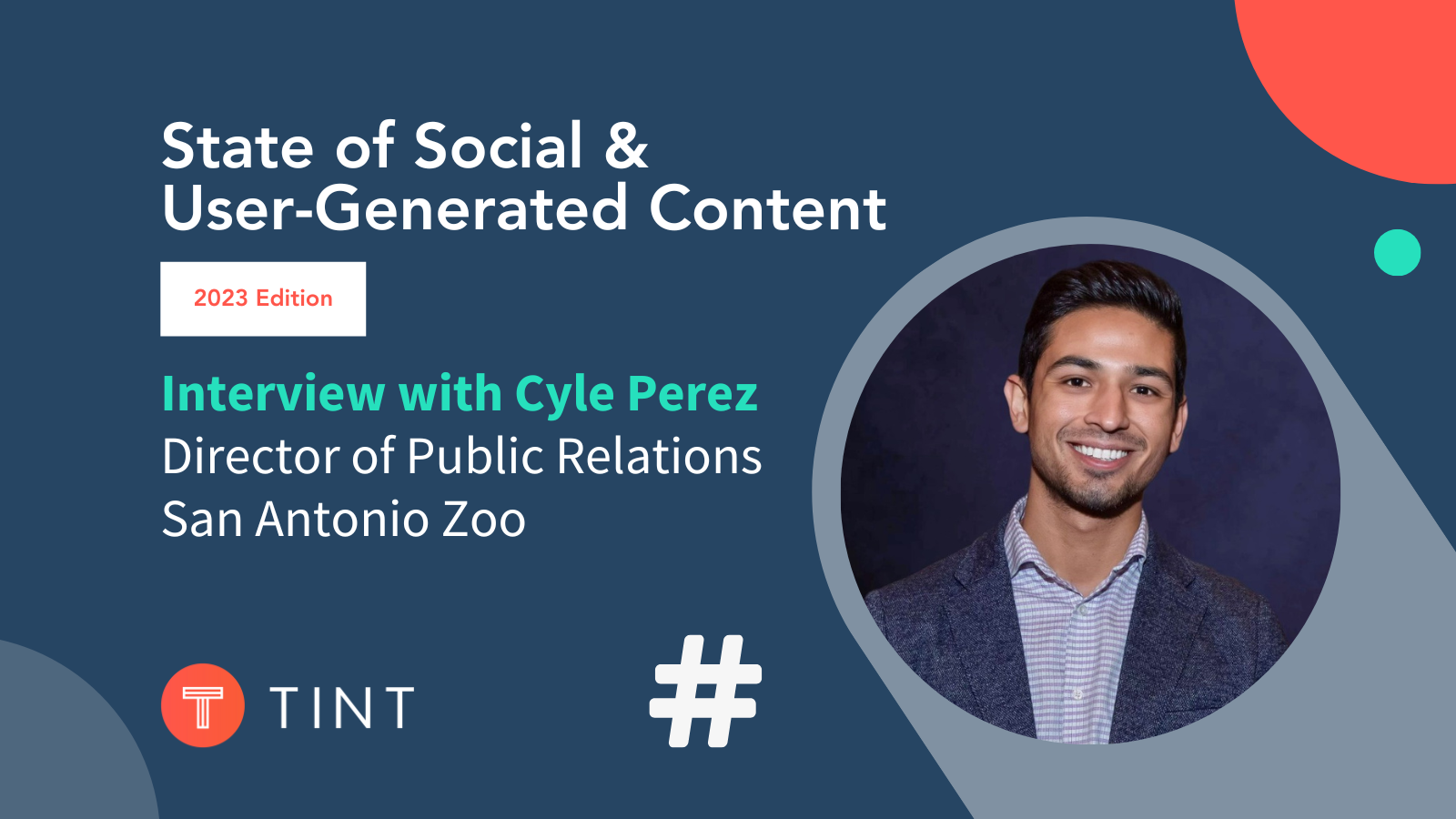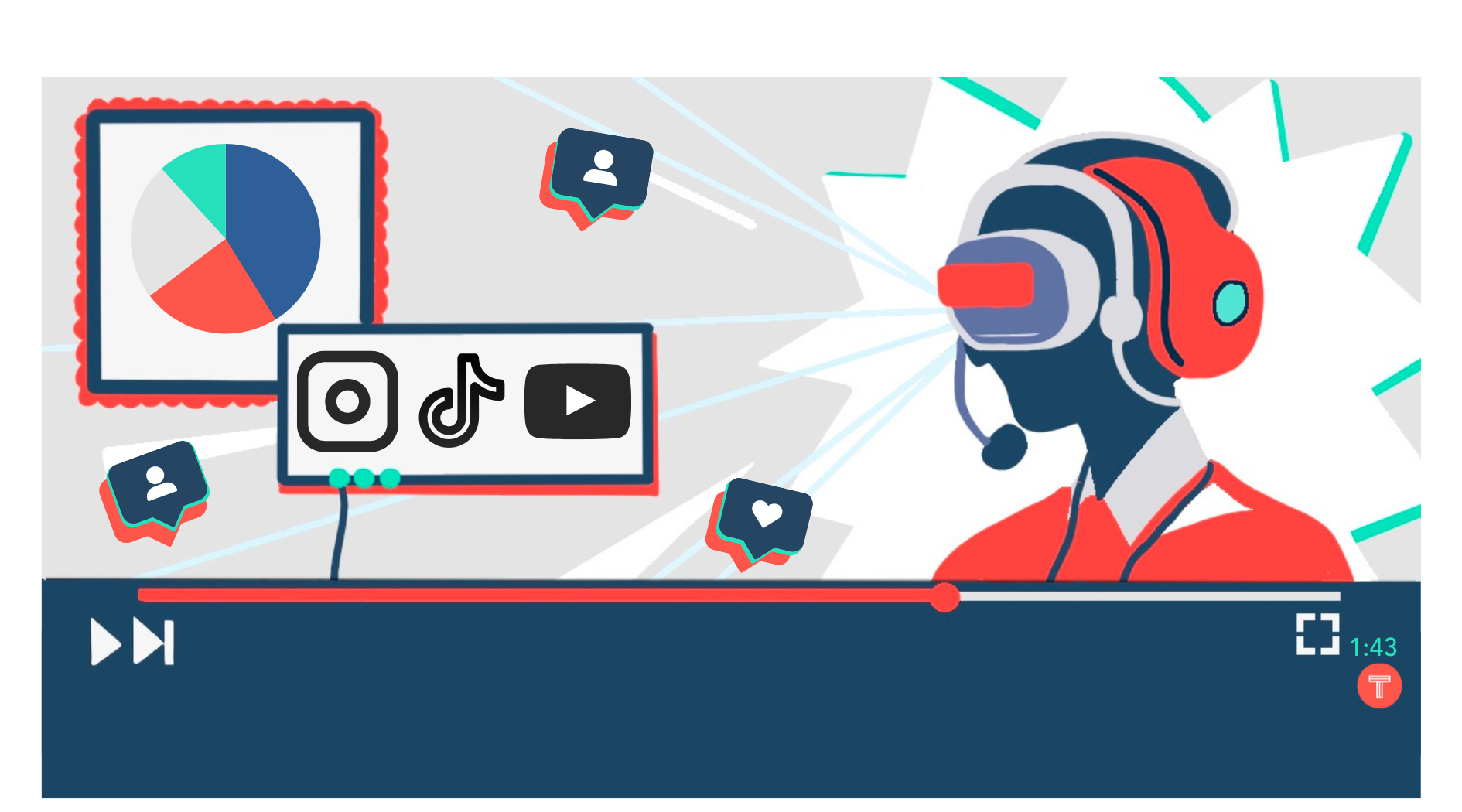This is an interview with Cyle Perez, Director of Public Relations at San Antonio Zoo. The transcript has been edited for brevity and clarity.
Download your copy of the 2023 State of Social & User-Generated Content.
David Ramirez
Let’s start off with who you are, what you do, and where you do it.
Cyle Perez
My name is Cyle Perez. I am the Director of Public Relations at San Antonio Zoo. In that falls all of our PR work and our social media department.
David Ramirez
For those who do not know the greatness of the San Antonio Zoo, give us a quick plug.
Cyle Perez
The San Antonio Zoo is a 501(C)3 nonprofit. We’re 108 years old, here in San Antonio, in a prime location right in the center of the city. Every ticket that’s purchased at San Antonio Zoo goes straight back to conservation here in Texas and all around the world. In reference to social media, we hit 4,000,000,000 (4 billion) in reach in 2022 with over two billion views.
David Ramirez
Congratulations! That is a huge number!
I’m excited to chat about The State of Social and User-Generated Content. I know you had a chance to review an advanced copy. Let’s run through a couple of the themes.
Theme 1: Doubling down on video (and audio) content
David Ramirez
We seeing more investment from marketing and communication professionals across the board in video and audio. What are you all doing at The Zoo in the video space already, and is there anything different or interesting you’re doing in video and audio for this coming year?
Cyle Perez
In 2022, we started to ramp up our video work. A lot of the attention spans we see nowadays are short. In small snippets, people can consume quickly and then move along. You are competitive in the space if you have enough of those small snippets. You start to get into people’s feeds more and more.
It helps to work at a zoo because we have a lot of cute animals. Our bread and butter is showing these cute animals in their habitat interacting with enrichment items. Short videos have really been successful for us.
The new thing that we’re doing for 2023 is working with trending sounds to tell these stories. We’re starting to use that trending audio to get into the algorithm more.
David Ramirez
I think about the zoo, and I think about the soundscape of a space like that. You can tell when you’re near the big cats. You can tell when you’re near certain animals. Have you thought or experimented at all with creating sounds at the zoo and uploading it to platforms like Tiktok, Clubhouse, or Linkedin audio?
Cyle Perez
Somewhat. We’re working on getting those animal sounds and putting them throughout the zoo on QR codes. Also, bringing in composers who will then create music based on these animals.
Social media will be part of that story, but we haven’t considered making it a sound for others to use as well. But it seems to be where everything’s going because if that [sound] hits, then other people are interacting with it. Then you get organic user-generated content.
Learn more about the trends discussed in this blog. Get your free copy of the State of Social & User-Generated Content.
Theme 2 – Social Media as a Search Engine
David Ramirez
We’re seeing Gen Z, young millennials, and Gen Alpha skipping Google and using social media as their primary place to search. How are you adapting to the idea that it’s not just your Google Adwords driving traffic, but it needs to be your SEO on a platform like Tiktok?
Cyle Perez
Personally, that’s how I search for things too. I’d rather go to a hashtag then the brand. What’s the story that they’re telling from their own mouths, and then what’s the story that their customers are telling?
Theme #3 – Return on Investment for social
David Ramirez
As a robust marketing organization with more than a century of history, I’m sure there is the challenge of attribution, being able to tag back ticket sales to specific channels or media. What things are you doing to track ROI for specific channels this year, and are there any specific challenges that you’re working through as part of your 2023 plans?
Cyle Perez
I’m over our public relations. A lot of that is earned or “free” media. We do have paid elements like targeted ads and billboards. We measure click-through rate, and how people get to our website. As a nonprofit, we don’t have the most robust backend. But, we can see where people are coming from, what interests them, and the basic demographics of our audience.
We’re about to step into an event called “Meet Your Next Ex.”. That’s not really the “traditional” San Antonio Zoo audience. Meet Your Next Ex is a specific target and so we use different graphics, different social media, with even different a voice. By targeting these people specifically on social, we can really see a better return than if we were to put even a commercial on TV because the event is highly curated to a younger, digital audience.
You funnel your dollars into something that you know gets in front of the people you want, instead of casting a large net like it used to be.
David Ramirez
Looking back at what you all did in 2022, was there any specific media or campaign you were surprised took off? You were not expecting it to be as successful or as powerful as it was?
Cyle Perez
We’ve done a lot. We did a Black Friday sale. We did Timothy’s twenty-five days of Christmas, and it’s all the storytelling of it. There are a lot of stories to tell at a zoo.
Like Timothy, he’s a famous hippo that writes love letters to a hippo in Cincinnati. We built him a brand. People follow him. He’s got his own Facebook page with thousands of followers. People tune in every Thursday to see what he writes to the Cincinnati hippo. Using these brand pillars and these followings helps us with those campaigns.
A lot of it was due to targeting and truly getting in front of people over and over again. But we broke every single record for every campaign that we did in 2022, and all of that has to do with social media.
Theme #4 – UGC is the most trustworthy content
David Ramirez
People trust other people that look and behave like them. What UGC have you seen out there that’s been created for the zoo (by visitors), and have you used any strategies to incorporate that into your different media and channels?
Cyle Perez
Actually, what I found most interesting about the report was the idea of incentivizing UGC to happen. We’ve seen this done before, but it’s not something the San Antonio Zoo has considered.
We’ve worked with influencers and creators. Really just for getting people excited. For instance, in the “Cry Me a Cockroach” campaign, you can name a cockroach after your ex, and then we feed it to an animal. That’s millennial gold. People love to see it. It’s petty, and so that gets its own traction.
The best content that we’re seeing, and the best traction we’re seeing, is from user-generated content. It almost doesn’t matter how much we get influencers involved or how much content we generate on our own. It’s the UGC that’s actually going to go viral and get a further reach than whatever we pre-plan and push out there. So, I really loved reading about the idea of incentivizing.
We have around 200,000 followers on Instagram. If we were to reshare somebody who tags us, that excites the audience, that excites the customer who we are resharing because you’re getting all these eyeballs that you wouldn’t have otherwise gotten. In a way, that is an incentive to be featured on the San Antonio Zoo page. People love the zoo; in turn, we can truly get this authentic content that comes from the voice of our guests.
Theme #6 – Stock Photography is Out
Learn more about why marketing and communications professionals are avoiding stock photography. Read the full theme and research in the State of Social and User-Generated Content.
David Ramirez
Another big trend that we’re seeing this year is that people are done with stock photography. Folks are quick to identify the same picture in that mortgage commercial, that was also in that foot cream ad, that’s now in this influencer ad, and so on. What are your thoughts on stock photography?
Cyle Perez
This report sheds light on the next generation and what they’re interested in, and truly it’s transparency. Stock photography doesn’t lend itself to any of that. I think it really helped us, as marketers, in a new world where we have to get all this content out there. We’ve got to build graphics. We got to build billboards and show people the experience.
But after a while, as the new generation came up, we know that’s not the experience. I’ve seen that same photo in all these different areas. We have an in-house team of a videographer, a photographer, and a bunch of cute animals. So we can create our own content and it’s important for us to do so. Every event that we have we staff a photographer. But, I think it’s really important to have authentic photos that show the experience.
No matter what event I go to, I want to see what that experience will be like before I get there. That’ll make me decide whether I want to spend my time doing it. It’s important to use original content. Stock photos are a little inauthentic.
Theme #7 – Influencers vs. Creators
David Ramirez
The next theme is about more clearly defining the boundaries between what is an influencer and what is a creator. How do you approach influencers and creators as you’re doing your planning?
Cyle Perez
We’re still at the beginning stages of exploring this world. We’re creating a “Zoo Troop,” as we call it. It’s kind of like a club of influencers. They have audiences that aren’t necessarily our audience. We have a large audience, but it’s in a particular field. People who want to see cute animals. They might not necessarily live in San Antonio. They could live all around the world and follow us because of our social presence. But, we need people to physically come through the zoo in San Antonio, Texas.
I look for influencers that kind of have that audience that might not necessarily be our traditional [audience]. I might go to a foodie influencer who would enjoy coming to our Zoo-la-la event, where we have over 50 restaurants come through and serve food.
Theme #8 – Ratings & Reviews
David Ramirez
The final theme is ratings and reviews. We are seeing people asking for more and more of them. How are you dealing with these sorts of expectations to see more customer testimonials, and how are you amping up your efforts to collect them?
Cyle Perez
That’s why I really love this report. We’re starting to expand in this world and start to consider these things as a top priority. Of course, we want good ratings. We want to ensure that we leave a satisfied guess after they experience our attraction. But we need to start utilizing that more. We have a survey that we send guests, but we don’t do anything with it on our end.
I think people really respect the transparency of seeing a review or understanding how people perceive you. You always want to make sure that you ask and that you encourage people or even incentivize people to give you that rating.
David Ramirez
What was the most interesting or surprising fact that you found in the report?
Cyle Perez
The most interesting theme to me was about UGC being the most trustworthy content. Then, seeing the graph of where everything landed and what was important to people. Influencers have kind of gone in and out a little bit. The consumer is realizing people are paying these people; are they that trustworthy? It’s fun to see how the market changes as the consumer becomes knowledgeable of how the backend works. Truly the marketer isn’t behind the curtain anymore. We are all experiencing it together, and we’re all holding each other accountable.
David Ramirez
Where can people go to learn more about the San Antonio Zoo?
Cyle Perez
They can go to sazoo.org. We have 21+ events. We have children’s programming. We have behind-the-scenes where you can pet a rhino or feed a hippo. And all of it’s in the name of conservation. Any money you spend there is all in the name of good. We hope to see you soon.
—-




